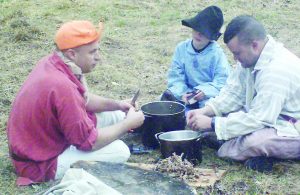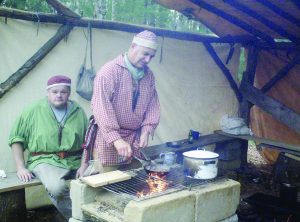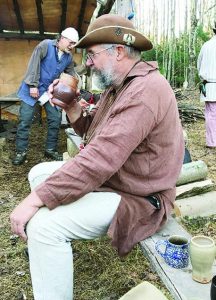by James C. Fulmer | Past President NMLRA

Lucas Fulmer, center, with his Uncle Mark to his left and his Dad to the right helps prepare the Squirrel Stew.
This December brings to a close the 2017 chapter in my book. As I get older I am starting to listen more than I talk. Many people find that hard to believe, but I am finding people more interesting in my old age. I always enjoy introducing people to new ideas and different books to read. Buddy Townsend spent a day reading one of the books I own of the Collected Poems of Robert Service while waiting for me to come home from work, so we could start on our annual squirrel hunt. Many people have introduced me to new books. Hearing me complain about Millennials, a friend told me, “That’s nothing new, read Elbert Hubbard’s book that was published in 1899, A Message to Garcia.”
A Message to Garcia is actually based on a true story about young Lieutenant Andrew Rowan who was sent on a mission to deliver a message from then President William McKinley to the leader of the Cuban rebels, Calixto Garcia. The tension between United States and Spain (which ruled Cuba at the time) was growing and the Spanish-American War was about to erupt. It is a great little book to read and is one of the few books written on what it takes to be a hard working follower. Lieutenant Rowan’s initiative is something that employers wished all their employees had while working. In 1899 when it was written, they had the same problems with finding employees who could work without supervision and complete assignments promptly. The little book was written well before there where Millennials. Go to the internet and type in “A Message to Garcia” to learn more. It is a great read.
You have heard this before, when a successful business man was asked what his three top tips for success were, he said, “That’s easy. Read something no one else is reading, think something nobody else is thinking, and do something no one else is doing.” Pretty simple really, but rarely done. It’s one of the many reasons I love muzzleloading. Muzzleloading fits all three of those categories.

The “Squirrel Shack” with raised hearth; Mike Wengert, left, and Norm Hoover cooking.
By shooting a muzzleloader you are you are doing something nobody else is doing. Since the invention of the cartridge the muzzleloader faded fast into history. The muzzleloading shotgun hung on well into the cartridge era because of being inexpensive compared to the modern shotgun of the late 19th century. When you load a muzzleloader it is like making a custom reload every time. Most powder measures are adjustable so you can easily change the amount of powder you put in the barrel: from light loads for target shooting, to hunting loads for shooting long range. Most muzzleloaders only have one sweet spot which is the most accurate for target shooting. A patched round-ball rifle with a slow twist is more forgiving for an accurate load and also the bigger the caliber the more forgiving it is. All rifles are different and you have to work up your own loads. My .32caliber flint squirrel rifle shoots the most accurate at 30 grains of FFFG of black powder. Anymore or any less it doesn’t do well, my .32 cal percussion shoots its best at 25 grains FFFG black powder. But since you are the loader of your muzzleloader, you have the control over accuracy, velocity, and energy of the muzzleloader. As a cartridge gun shooter you don’t have all that unless you reload your own, but with a muzzleloader every shot is a reload.
Hunting with a muzzleloader for big game is nothing but plain fun. You have to be a more skilled hunter and have more patience to get the perfect shot. Also when we hunt whitetail deer here in Pennsylvania, we change our tactics by putting hunters closer together on stands. You only have one shot and you really don’t want to shoot more than 100 yards. What you really want is your gun set up for 50 yards or less.
But the real fun hunting for me is squirrel hunting. This year the annual squirrel hunt I go on had 16 participants. The hunt was started 38 years ago in 1979 as a pre-1840 event. We backpack in and we only allow a couple potatoes, carrots, an onion, and a few apples – no meat. Wow! After about five years of that we added: bacon, sausage, ham, and eggs. Squirrel has always been the main stay in the pot, but sometimes a turkey, three to be exact in 38 years, and about the same with grouse and several porcupines. But mostly this year it was squirrel. This year 16 of us shot during the Saturday hunt. Over the years most hunters carry flint smoothbores or double barrel percussion shotguns. There was one double flint 20 gauge shotgun. Only three rifles were carried and they accounted for 4 of the squirrels. Sean Rowland got three of the four and it was his first year at the hunt. This was one of the better years for squirrel here in Pennsylvania. Of the 13 people carrying muzzleloading smoothbores, four were flint, including the double barrel. Of the other nine double barrel percussion shotguns, six of them were originals. Originals are actually cheaper than many reproduction double barrels muzzleloaders. The reason is, is because there were so many muzzleloading shotguns made between 1840 and 1880. Muzzleloading shotguns where very common and almost every settler that went west took one with them mostly because they are versatile from shooting game to self-defense.

Author in “Squirrel Camp.”
Over the years we go back to the same spot for our squirrel hunt and we built a common shelter at the campfire. It’s mostly because of snow. We actually got wetter from a snow storm than we ever did from rain. The heavy wet snow stuck to us and melted and made us miserable, so the next year we built a frame work that we covered with canvass made to just fit that shelter. The latest addition to the squirrel shack was a standing hearth for cooking. Of the sixteen people at this year’s hunt five where over 60 and one of those five was over 70 years old. Squatting by the campfire cooking was starting to chase some of the original founders of the hunt away. The raised hearth was a great addition. It’s hard to keep the kids from monopolizing it.
Doing events like this, you will be surprised how much you read on winter campaigns of the French & Indian War and the American Revolution to see just how they dressed and kept warm. How did they preserve and kept their food; how they even hunted squirrels. When you got involved in muzzleloading did you ever think you would have learned all that you have about the history of the muzzleloading era? Aren’t you glad you did?



